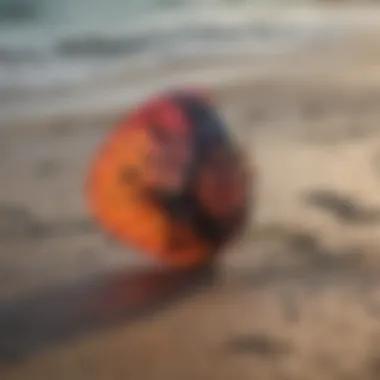Essential Kite Repair Parts for Enthusiasts


Intro
Kite repair is not just for the unfortunate souls who end up with a ripped canopy or broken lines; it's a crucial aspect of maintaining peak performance and safety during your rides. Understanding the various components that make up your kite, and how they can break down or wear out, is fundamental to any true kiteboarding enthusiast or kitesurfer. This guide serves to shed light on kite repair parts, their significance, optimal selection, and the best practices for keeping your gear in top shape.
Whether you are a beginner just dipping your toes into the world of kiteboarding, or a seasoned rider seeking some advanced tips, comprehending kite repair parts will enhance your overall experience. By the end of our exploration, readers will have a deeper insight into the importance of proper maintenance, which leads not only to longevity of the equipment but also ensures your safety on the waters.
In this guide, we will traverse through equipment reviews, travel hotspots, techniques, and safety protocols. More than just a string of parts under a colorful canopy, each component plays a significant role in your kite’s performance and your own riding experience. Let’s dive deeper!
Foreword to Kite Repair Parts
When it comes to kitesurfing or kiteboarding, understanding kite repair parts is vital. Your kite is more than just a colorful sail filling with wind; it’s a finely-tuned setup that demands care and attention. The maintenance of your kite can greatly affect your performance, enjoyment, and even safety while out on the water. Mapping out the various components involved in kite repairs helps in recognizing their significance and the benefits of keeping high-quality parts on hand.
Importance of Kite Maintenance
Kite maintenance is often overlooked until something goes wrong. However, being proactive about your kite's upkeep can save you from costly repairs or, worse, dangerous situations while riding. Regular maintenance can extend the life of your kite significantly. For example, just like a car needs oil changes, your kite requires regular inspections for any worn-out or damaged parts. Imagine heading out for a day of kitesurfing, excited and ready, only to discover a rip in your sail or frayed lines. It’s like jumping into a car with a bad tire – you’re setting yourself up for trouble.
Maintaining your kite not only prevents issues but also enhances your stable performance in various conditions. Using proper parts suited for your kite model enriches the ride, allowing for precise maneuvers and better responsiveness. Regular check-ups and replacements might seem like a chore, but they ensure that when you hit the waves, you’re doing so with confidence and safety in mind. Employing a few simple techniques can make all the difference.
Overview of Common Repair Needs
Understanding common repair needs could be the difference between a joyous day on the water and a frustrating experience spent tinkering with your gear. Several parts are often the stars of the repair show.
- Kite fabric: Tears and rips can occur from various factors, including accidents or rough handling. Patches are handy to have.
- Leading edge: Damage here is not uncommon, especially after a tough landing. Knowing how to reinforce or replace this part can save a kite.
- Lines: Wear and tear on bridle lines or flying lines is typical in the sport. Being vigilant about their condition is crucial.
- Struts and framework: These parts often face pressure during flight. Identifying cracks can help prevent further damage.
- Control bar and line sets: Issues can arise as equipment ages. Regular replacements keep everything functioning smoothly.
"Proper knowledge about what parts to repair can not only save you from breakdowns, but also elevate your kitesurfing experience to new heights."
Types of Kite Repair Parts
Understanding the various repair parts of a kite is crucial for enthusiasts wanting to maintain their gear in top shape. Each part plays a specific role, influencing the kite's overall performance and safety. From fabric to the framework that holds everything together, knowing what’s what can save you both time and money in the long run. The parts you choose not only need to fit your specific kite model but also shouldn’t compromise on quality. The right repairs mean fewer mishaps down the line, which is especially important when you’re out on the water or soaring high in the sky.
Kite Fabric and Material Patches
The material of your kite can take quite a beating, especially in harsh wind conditions. Fabric patches are essential for covering up rips or tears that may occur during your kite's lifecycle. These patches must be made from durable, weather-resistant materials and should closely match the kite's original fabric for seamless repairs. Depending on what type of kite you have—whether it’s a foil or a framed kite—you may need different types of patches.
Considerations for fabric patches:
- Strength: Look for patches with high tensile strength.
- Adhesion: Self-adhesive patches can save you time but make sure they stand the test of wind.
- Color Matching: A good color match helps in avoiding noticeable repairs on your kite.
"Effective kite repairs often begin with the right materials. A patch can make or break your flight."
Leading Edge Repair Solutions
The leading edge of a kite is akin to the spearhead of an arrow. Damage here can greatly affect the kite’s performance, making it prone to diving or losing stability. Repair solutions for this area include reinforced tape or specialized leading edge splicing kits that can offer significant quality. You might want to consider options that combine both quick-fix and permanent solutions.
Key options for leading edge repair:
- Reinforced Tape: Strong and flexible, ideal for temporary fixes.
- Splicing Kits: Provides a more permanent solution, good for those who fly frequently.
Bridle Lines and Connectors
Bridle lines are vital in ensuring the correct balance and stability of your kite. Damaged lines can cause erratic flying behavior and may even put you in a dangerous spot. Replacing or repairing bridle lines can be straightforward if you know what you're looking for. Always keep spare lines handy. You shouldn’t overlook the connectors either; they play a vital role in holding everything together.
Important aspects to consider:
- Material: Go for high-quality lines that are UV resistant.
- Length: Ensure the lines are cut to a length that matches your kite’s specifications.
- Connectors: Inspect for rust or corrosion; they should be easy to attach and detach.
Struts and Framework Components
Struts serve as the backbone of a kite. They provide structure and stability, making them fundamental for effective flying. Damage to struts can severely impair performance. Generally made from lightweight yet sturdy materials like fiberglass or aluminum, they require careful inspection and timely replacement.
Repair tips for struts:
- Visual Inspection: Regularly check for cracks or bends.
- Replacement Options: Have a backup set of struts meant for your specific model handy.


Control Bar and Line Sets
The control bar is the pilot’s primary interface with the kite, translating hand movements into aerial maneuvers. A properly functioning control bar ensures that you maintain optimum control in gusty conditions. Line sets, on the other hand, include the lines that connect the control bar to the kite, and they play a crucial role in handling.
Checklist for control bar and line set maintenance:
- Wear and Tear: Look for frayed lines and check the bar’s integrity.
- Adjustment Mechanisms: Ensure they work smoothly.
Choosing the Right Parts
When it comes to kite maintenance, selecting the right parts may seem like a minor detail, but don’t let that fool you. The wrong components can easily lead to mishaps, injuries, or even a ruined kite. Getting this part right is crucial for performance, safety, and longevity. Making informed choices not only enhances your overall kiting experience but also ensures that you’re flying with equipment you can trust.
Assessing Quality and Durability
Before making any purchase, it’s essential to consider the quality and durability of the repair parts. Not all materials are created equal. For example, when selecting fabric patches, opting for higher denier count can drastically change the life expectancy of your repair job. Look for brands that are well-regarded within the kiting community; feedback and reviews can provide insights you may not find in a product description.
- Key Factors to Consider:
- Material Composition: Is it ripstop nylon or something cheaper that won't hold up in the wind?
- Environmental Resistance: Will it stand up to sun exposure and saltwater?
- Previous User Feedback: What is the community saying about its longevity and quality?
By scrutinizing these elements, you can make confident choices that will endure the tests of time and nature, thus safeguarding both your kite’s performance and your personal safety.
Compatibility with Different Kite Models
The variety of kite models available today is mind-boggling, each with its unique specifications and designs. Hence, it is imperative to ensure that the parts you're purchasing are compatible with your particular kite model. Ignoring this can result in mismatched components that could affect functionality—potentially compromising your enjoyment and safety.
- Compatibility Checklist:
- Manufacturer Recommendations: Always check if the parts are listed as compatible by the original manufacturer.
- Model-Specific Requirements: Some kites, especially high-performance ones, have very specific needs for components.
- User Forums: Engage with forums and online communities where kitesurfers discuss their compatibility experiences.
Finding the right fit between your kite and the repair parts not only optimizes performance but also lays a solid foundation for safer kiting adventures.
Sourcing Reliable Suppliers
Where you source your kite repair parts can make all the difference. Opting for reliable suppliers ensures that you’re getting what you pay for. This isn't just about avoiding cheap knock-offs; it's about investing in your safety and performance. It’s worth digging a little deeper to find vendors who specialize in kiting and understand the nuances involved.
- Things to Consider:
- Reputation: Look for suppliers with strong reviews from fellow kitesurfers and extreme sports enthusiasts.
- Customer Service: A supplier willing to help with questions or concerns is invaluable, especially if you're new to repairs.
- Return Policies: Good suppliers won’t just sell you parts; they offer reasonable return policies, giving you peace of mind.
In essence, sourcing parts from trustworthy suppliers is a cornerstone of successful kite repairs and maintenance. It enables a more seamless experience, lessening the chances of unpleasant surprises when you hit the beach again.
"Choosing the right parts for your kite can be the difference between soaring high and crashing down. Don’t take shortcuts; care for your gear like it cares for you!"
Ultimately, choosing the right parts is not merely about functionality; it’s about ensuring your kite serves you well, letting you focus on what really matters: the exhilarating experience of kiting.
Basic Kite Repair Techniques
Understanding basic kite repair techniques is crucial for any kitesurfer or kiteboarding enthusiast aiming to extend the life of their equipment and ensure safe operations during their rides. When you're out there battling the winds and feeling the freedom, the last thing you want is a malfunctioning kite. Knowing how to identify damage, apply necessary patches, and adjust lines can mean the difference between a perfect flight and a dive into the depths of a bad situation.
Identifying Damage
Before you can fix any kite, you need to understand what needs fixing. Damage can range from small fabric tears to misaligned bridle lines. A few common signs of damage include:
- Visual Inspections: Always keep an eye out for wear and tear. Look for anything that appears out of the ordinary.
- Functional Tests: Pull on your lines to check for excess slack or tightness, as these can suggest deeper issues with the bridle or frame.
- Feel for irregularities: When inflating the kite, if you notice any unusual bumps or soft spots, it could indicate compromised integrity.
Identifying issues early can save you not just time but also money by preventing more severe damage.
Steps for Fabric Patch Installation
Once you've identified a tear or hole in the fabric, patching it correctly is essential. Follow these steps for a solid repair:
- Clean the area: Remove any dirt or sand stuck around the damaged part to ensure the patch adheres properly.
- Choose the right patch material: Use a fabric that closely matches your kite's material, ideally some ripstop nylon or specific kite fabric.
- Cut the patch, making sure it overlaps the tear by at least an inch on all sides.
- Secure the patch: A good adhesive works wonders; some opt for specific kite repair tape which can be easy to apply. Press it firmly down and consider stitching around the edges for extra durability.
- Let it cure: Give the adhesive enough time to set before trying to fly again.


By taking these steps, you transform a potentially flawed kite into a flying machine again.
Line and Bridle Adjustment Procedures
Proper line and bridle adjustments are vital to maintaining the performance of your kite. Misaligned lines can lead to erratic behavior in the air, causing a less enjoyable ride and potentially hazardous situations. Here’s how to get them back in shape:
- Check line lengths: Make sure all lines are equal in length. A quick way to gauge this is to lay them out on a flat surface next to each other.
- Inspect connections: Look at the points where your lines connect to the kite. These areas can wear down over time, so replace any frayed or damaged connectors.
- Adjust bridle tension: Ensure the bridle lines are neither too tight nor too loose; this can significantly impact how your kite performs. Adjust by looping or pulling the lines accordingly.
Taking a few moments to go over these adjustments can prevent disastrous results when you’re about to launch.
Maintaining your kite through these basic repair techniques not only enhances performance but also cultivates a sense of connection between you and your gear, making every flight a joy to take. Regular practice of these techniques can ensure you’re always ready for the skies.
Preventative Maintenance Strategies
When it comes to kite repairs, being proactive is often better than needing to be reactive. Preventative maintenance can save kitesurfing enthusiasts both time and money in the long run. By ensuring that kites are regularly maintained, damage can be minimized, and performance can remain at peak levels. Here’s a closer look at some essential strategies for keeping your kite in tip-top shape.
Regular Inspections and Cleaning
Routine inspections and cleaning are vital components in the maintenance journey of a kite. A common mantra among kite enthusiasts is, "A clean kite flies better," and that rings true for good reason. Regularly checking your equipment can help you spot potential problems before they escalate.
Inspect your kite before and after every session. Look for any signs of wear and tear, such as frayed lines, loose seams, or punctures in the fabric. Pay special attention to high-stress areas like the leading edge and trailing edge. If you notice any damage, it’s generally best to address it immediately.
Cleaning is another critical aspect. After a day on the beach, saltwater and sand can cling to your kite, leading to deterioration. A simple rinse with fresh water can remove these harsh elements. After rinsing, ensure that your kite dries completely before packing it away, as moisture can lead to mold and mildew.
"An ounce of prevention is worth a pound of cure," as the saying goes. A little attention to detail in maintenance can go a long way.
Proper Storage Techniques
Proper storage of your kite can significantly enhance its lifespan. Many kitesurfers overlook this aspect, assuming that their gear is safe as long as it’s out of sight. However, improper storage can cause just as much damage as neglecting repairs.
Here are a few key points to consider when it comes to storing your equipment:
- Avoid Extreme Temperatures: High heat can warp and weaken the materials of your kite, while stark cold might make them brittle. Store your kite in a climate-controlled environment if possible.
- Use a Quality Kite Bag: Invest in a durable bag designed specifically for kite storage. This will protect against scratches and punctures when the kite is stored away.
- Loosely Pack Lines and Accessories: Cramming cables and components can lead to tangling and damage. Instead, roll them up loosely and store them separately from the kite fabric.
Creating a dedicated storage space specifically for your kitesurfing equipment will make it easier to keep everything organized and in good condition.
Understanding Environmental Impact
Be mindful that your surroundings can greatly influence your kite's condition. UV rays from the sun can break down materials over time, leading to more rapid degradation than you might expect. Here are a few considerations that can help mitigate environmental effects:
- Sun Protection: After a session, if you're not planning to use the kite again that day, try to keep it out of direct sunlight. Consider using a tarp or blanket for extra protection against UV rays if you plan to leave it outside for a while.
- Dealing with Salt and Sand: Salt from seawater is corrosive, and sand can act like sandpaper on the kite surface. Be diligent in cleaning your gear after each outing to prevent long-term damage.
- Weather Patterns: Understanding your local climate and seasonal conditions can also help you plan your kitesurfing sessions. For example, avoid kiting during lightning storms or strong winds; this protects not only your equipment but also your personal safety.
By embracing these preventative maintenance strategies, you can extend the life of your kite while ensuring that it performs at its best whenever you take to the skies. A bit of cautious care goes a long way.
Expert Insights on Kite Repairs
Gaining knowledge from experts can elevate your kite repair skills immensely. Professional repair technicians have hands-on experience and a wealth of insider knowledge. Their insights can guide enthusiasts in understanding the nuances of maintenance, repair techniques, and selecting the right parts. The kite world can be complicated; knowing where to turn for help simplifies things and ensures gear longevity. Repair experts often possess solutions that aren't widely known, which can save both time and money.
Interviews with Professional Repair Technicians
Talking to professionals in kite repair is like tapping into a treasure trove of information. These technicians have seen it all—from the botched DIY repairs to the meticulous restorations that come out looking like new. Each technician brings a unique perspective on the art and science of kite repairs.
In these interviews, technicians share practical tips. For instance, one technician advises checking the seams regularly for fraying, which can be easily overlooked. Understanding the material used in your kite helps too; some fabrics respond better to certain repairs than others.
"I've seen a lot of kites get destroyed simply due to a lack of basic maintenance. It's crucial to catch problems early," one expert mentioned.
Prominent issues discussed include:
- Common Damage: Rips, tears, and general wear.
- Material Choices: Different fabrics call for different repair materials.
- Tools Needed: You may need specific tools to handle repairs effectively, which saving you from frustration down the line.
Success Stories from the Community
Stories from fellow kite enthusiasts often resonate deeply within the kiting community. Hearing about real-life successes or mishaps can inspire others to either try a repair themselves or approach the process with more caution.


Such community stories often highlight the unexpected benefits of repair endeavors. For example, a long-time kiter shares how a minor tear in their fabric led to discovering they could upgrade to a newer, stronger material that improved performance.
Additionally, these narratives often encourage newcomers to engage with experienced users, fostering a sense of camaraderie. Those involved in the kiting community are usually willing to share what they learned from both their achievements and mistakes, enriching overall knowledge.
"Repairing your kite not only saves money but also enhances your understanding of how your gear works. It's a win-win situation that brings you closer to the sport you love."
This community-driven approach encourages enthusiasts to share tips on which repair products work best, thus circulating valuable information across forums and social networks. Whether through Reddit threads or Facebook groups, these stories provide a wealth of knowledge that can guide both new and seasoned kitesurfers in their repair journeys.
Safety Considerations
Safety is paramount when it comes to kite flying and kitesurfing. The equipment you choose not only affects performance—but also your overall well-being. Understanding safety considerations ensures that your kite experience isn’t just thrilling but also secure. With various components involved, it’s essential to stay informed, keeping yourself and those around you safe.
Recognizing Unsafe Equipment
Kiting can be liberating, but it’s crucial to spot equipment that has seen better days. One significant area to examine is the lines. Worn or frayed lines can snap. This doesn’t just ruin your day; it can also pose serious risks. Check the fabric for tears or holes—these can drastically alter how a kite flies. Additionally, any unusual wear on the control bar or connectors might signal it's time for a replacement.
Regular inspections help catch these issues before they spiral out of control. Some indicators of unsafe equipment include:
- Frayed or worn lines: Inspect them regularly and replace when necessary.
- Visible damage to the fabric: Small tears can lead to bigger problems.
- Rust or corrosion on metal parts: This affects both function and safety.
- Loose components: Everything should be tightly fastened.
"It’s better to be safe than sorry—always do a thorough check before hitting the beach."
By adopting a proactive approach towards equipment maintenance, you’ll enhance your safety on the water. Keeping your gear in pristine condition is not just about performance; it's about ensuring that your kiting adventure is fun without a hint of danger.
Tips for Safe Kiting Practices
Safe kiting practices are about understanding your environment as much as they are about your equipment. Here are some insights:
- Know the Weather Conditions: Always check wind speed and direction before heading out. High winds can make for a dangerous outing.
- Select Appropriate Locations: Your kitesurfing spot should be free of obstructions like trees, power lines, or other beachgoers.
- Use Safety Leashes: A safety leash adds a layer of security by preventing your kite from drifting too far away if it disconnects.
- Practice with Wind Direction: Familiarize yourself with how your kite behaves at various wind angles; it can help you navigate effectively.
- Stay Courteous and Aware: Keep an eye on nearby kitesurfers and follow local guidelines. Everyone deserves a safe experience.
- Learn Emergency Procedures: Knowing how to respond to different situations can save your life or someone else’s.
In the world of kitesurfing, safety should never take a back seat. The more prepared you are, the more you’ll enjoy the sheer exhilaration of flying high and skimming over the waves.
Future Trends in Kite Repair Parts
As we look into the horizon of kite repair, it's clear that the industry is not standing still. There are exciting evolutions underway that promise to change how enthusiasts maintain and enhance their kites. Understanding these future trends is vital, as it opens doors to greater durability, performance, and even sustainability. The importance of this topic can't be overstated—it shapes how we interact with our kites and, ultimately, how we experience the thrill associated with kitesurfing and kiteboarding.
Innovations in Material Technology
Material technology is at the forefront of kite repair advancements. The emergence of high-performance fabrics is revolutionizing what kite repair parts can achieve. New lightweight composites, such as ripstop polyester blends, offer enhanced tear resistance and reduced weight. Meaning, even after repairs, kites are more resilient against the elements.
Notably, the development of self-healing materials—though still an emerging technology—shows promise. Imagine a kite that could automatically seal small punctures or tears with minimal intervention! This could revolutionize emergency repairs on the beach, reducing gear downtime and enhancing safety for kitesurfers who find themselves in unforeseen conditions.
Another fascinating trend involves integrating sensors into kite equipment. These sensors can monitor stress and strain on critical components, sending alerts to the user for preventive maintenance. Such proactive measures ensure that kites remain in tip-top shape, leading to longer lifespans and improved user experience.
Eco-Friendly Repair Solutions
The push for eco-friendliness in kite repair is gaining momentum, reflecting a broader societal trend toward sustainability. A key aspect of this movement is the use of recycled materials. Kite repairs traditionally relied on new products, often contributing to unnecessary waste.
Now, companies are exploring the use of recycled fabrics for making patches and parts. For example, some manufacturers are creating kite fabrics from repurposed plastic bottles. This not only reduces landfill waste but also transforms an environmental problem into a high-performance solution. Additionally, biodegradable adhesives are entering the market, allowing for cleaner, more sustainable repairs.
Moreover, the practice of localizing repair services is growing. Instead of shipping damaged kites across the globe, more local repair shops are emerging, reducing carbon footprints and supporting local economies. This movement emphasizes the importance of community and environmental responsibility, appealing to conscientious kite enthusiasts.
Research indicates that incorporating eco-friendly practices doesn’t just help the planet; it frequently results in more durable repairs that can withstand harsh conditions. Besides lowering the overall environmental impact, it can also foster a deeper connection between the athlete and their gear.
"Adopting eco-friendly practices in kite repairs not only benefits the environment but also enhances the kiteing experience, allowing enthusiasts to feel more connected to their gear."
Embracing these innovations and eco-friendly solutions will guide the kite community into a more sustainable and high-performing future, enhancing the total user experience and contributing positively to the planet. History teaches us that those who adapt to changes thrive, and this is no different in the kite repair landscape.
The End
In summing up the intricate world of kite repair parts, it becomes abundantly clear that understanding these components not only enhances the longevity of kites but also significantly improves the performance when soaring high in the skies. Kite maintenance is not just a recommendation; it is an essential practice that can save enthusiasts both time and money in the long run. A well-maintained kite can mean the difference between a peaceful flight on a sunny afternoon and an unwanted emergency landing due to sudden failures.
Recap of Key Points
- Importance of Kite Maintenance: Regular upkeep ensures your kite performs optimally, minimizing risks during flights.
- Types of Repair Parts: Familiarizing oneself with components like bridle lines, struts, and fabric patches helps in quick repairs.
- Choosing the Right Parts: Assessing quality is vital. Compatibility with your specific kite model is just as crucial, and sourcing from reliable suppliers cannot be overstated.
- Basic Repair Techniques: Knowledge of identifying damage and patch installation is fundamental for every kite surfer.
- Safety Considerations: Recognizing unsafe equipment and following best practices leads to a safer kiting experience.
- Future Trends: Staying informed on innovations and eco-friendly materials used in kite repair is important for sustainability.
Final Thoughts on Kite Maintenance
Maintaining your kite is akin to tending to a well-tuned engine; it demands attention and care. Those who consistently invest the effort will find their kiting experiences more rewarding. As our understanding of materials and repair techniques advances, so too will our ability to enjoy this exhilarating activity without concerns about equipment failure. The bottom line? A proactive approach to kite maintenance not only enhances enjoyment but also fosters a vibrant kiting community where individuals learn and grow together.
Remember, a kite in good health not only flies better but also contributes to a safer and more satisfying experience on the water or in the air.







